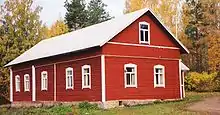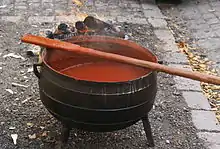Falu red
Falu red or falun red (/ˈfɑːluː/ FAH-loo; Swedish: falu rödfärg, pronounced [ˈfɑ̂ːlɵ ˈrø̂ː(d)færj]) is a dye[1] that is used in a deep red paint, well known for its use on wooden cottages and barns.

In Finland, falu red is known as punamulta ("red earth") in Finnish and rödmylla ("red dirt") in Swedish, after the pigment, which consists of finely divided hematite, iron(III) oxide (Fe2O3). Since the binder is starch, the paint is permeable to water. In Estonia, falu red is known as Rootsi punane ("Swedish red") and is most common in Western Estonia in the former Coastal Swedish territory.It's also the standard red for Norway along with a scarlet version and the shade of red is used in the flag of Denmark.
Origins
The pigment historically originated from mines at Falun, in the province of Dalarna, Sweden. It was a side product of calcination of copper ore. Mixed with linseed oil and rye flour, it was found to form an excellent anti-weathering paint.
The earliest evidence of the use of falu red dates from the 16th century. During the 17th century, falu red was commonly used on smaller wooden mansions, where it was intended to imitate buildings with brick facing.
In Swedish cities and towns, wooden buildings were often painted with falu red, until the early 19th century, when authorities began to oppose use of the paint. Increasingly many wooden buildings in urban areas had by then begun to be either painted in lighter colors such as yellow or white, or to be sided with stucco. The number of buildings made of bricks had also increased.
Resurgence
Falu red saw a resurgence in popularity in the Swedish countryside during the 19th century, when poorer farmers and crofters began to paint their houses. Falu red is still widely used in the countryside. The Finnish expression punainen tupa ja perunamaa, "a red cottage and a potato field", referring to idyllic nuclear family life, is a direct allusion to a country house painted in falu red.

Composition
The paint consists of water, rye flour, linseed oil and tailings from the copper mines of Falun which contain silicates, iron oxides, copper compounds, and zinc. As falu red ages the binder deteriorates, leaving the color granules loose, but restoration is easy since simply brushing the surface is sufficient before repainting.[2]
The actual color may be different depending on the degree to which the oxide is burnt, ranging from almost black to a bright, light red. Different tones of red have been popular at different times.[3]
References
- Svensk uppslagsbok, Malmö 1961
- "Archived copy". Archived from the original on 2016-03-22. Retrieved 2013-05-11.CS1 maint: archived copy as title (link)
- "Falu rödfärg Original - Falu Rödfärg". Falu Rödfärg (in Swedish). Retrieved 2018-03-17.
External links
| Wikimedia Commons has media related to Falu red. |